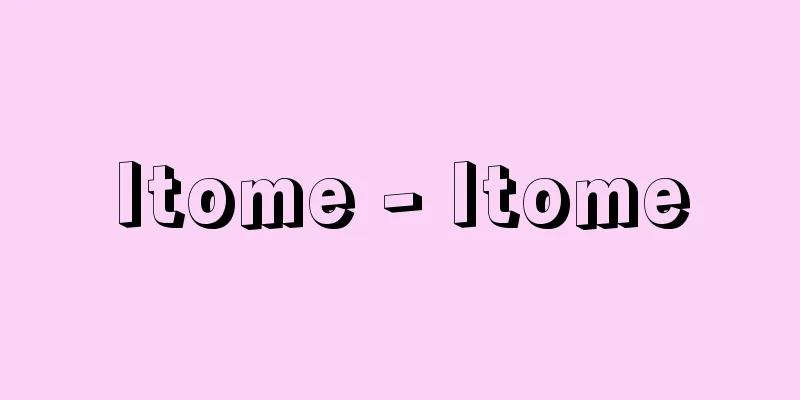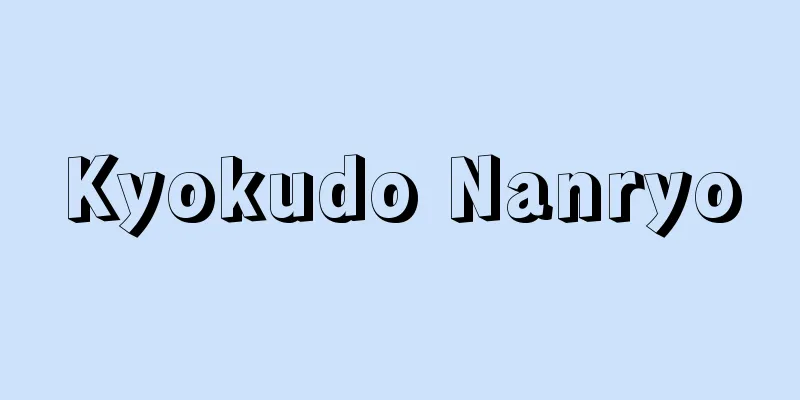Fish market - Uogashi

|
This refers to a riverside fish market that sells seafood wholesale to general traders, and can be found all over Japan. It is also the common name for the fish market (Nihonbashi Fish Market) that was located near Nihonbashi from the Edo period until 1923 (Taisho 12), and the seafood section of the central wholesale market (Tsukiji Market) that was located in Tsukiji, Chuo Ward, Tokyo from 1935 (Showa 10) to 2018 (Heisei 30). When the Edo shogunate was first established, fish were bought and sold in the area around Shibaura, which was called Zakoba, but fish caught off the coast of Shinagawa were particularly fresh, and were highly valued as fish caught in the sea in front of Edo, that is, Edomae Shibazakana. It is said that the fish market originally began when fishermen who came from Settsu sold the leftover fish they had delivered to the shogunate to the general public in the city. Later, Tokugawa Ieyasu granted fish sales rights to people from Mikawa, a local feudal domain, as a measure to prosper Edo. He set up a market along the riverside stretching from the north end of Nihonbashi to Aramebashi, and all the best seafood imported from various regions was sold at the market for official business. As a result, the riverside prospered day by day, and the Nihonbashi area formed a large shopping district with seafood specialty stores and related stores. In addition, the agile movements required by the handling of fresh food products naturally led to a rough and rugged disposition of the people, which gave rise to the unique temperament of the fish market, which boasted a spirit and good spirit that was connected to living creatures, and phrases such as "Edomae Tanka" (Edomae's tantrum) were born from the crisp, fast-paced everyday conversation. The Nihonbashi fish market continued to thrive even after the Meiji era, but in 1923 (Taisho 12), over 600 wholesale stores and brokerages were burned down in the Great Kanto Earthquake, so a temporary market was set up on the Shibaura reclaimed land and moved to Tsukiji in December of the same year. After a period of temporary operations and adjustments, it began full-scale operations as the "Tokyo Central Wholesale Market" in February 1935, handling the majority of the city's consumption. In October 2018, it moved to Toyosu, Koto Ward, due to the aging of the facility and overcrowding. [Nonin Sato June 18, 2019] [References] | | | |This painting depicts the bustle of the Nihonbashi Fish Market (Uogashi), once known as "Edo's Kitchen." It began as a whitebait market during the Tensho era (1573-1592), and developed into a fish market after permission was granted to sell leftover fish that had been delivered to the Edo Shogunate within the city. After the stores were destroyed in the Great Kanto Earthquake in 1923 (Taisho 12), the market moved to Tsukiji after being set up as a temporary market in Shibaura. It began operating as a central wholesale market in 1935 (Showa 10). Triptych owned by the National Diet Library "> Utagawa Kuniyasu, "The Prosperity of the Nihonbashi Fish Market" This nishiki-e depicts the Zakoba Market, Osaka's largest fish market, which flourished during the Edo period. Since its opening in 1679 (Enpo 7) in Sagishima (now Nishi-ku, Osaka), the fish market flourished as the center of small fish trading in Osaka, and the painting shows wholesalers and fishmongers carrying poles coming and going. Merchants began to call Sagishima, where the fish market was located, "Zakoba (small fish market)," and eventually "Zakoba" came to be used to refer to fish markets. Zakoba Market continued to exist after the Meiji period, but with the opening of the Osaka Central Wholesale Market in 1931 (Showa 6), it came to an end. ( Owned by the National Diet Library ) Hiroshige Utagawa, "Illustration of famous places in Naniwa: The Fish Market at Zakoba" A market was set up along the riverside area from the north end of Nihonbashi to Arafuji. "Tokyo Landscape" (1911 (Meiji 44)) Owned by the National Diet Library . Nihonbashi Fish Market Source: Shogakukan Encyclopedia Nipponica About Encyclopedia Nipponica Information | Legend |
|
魚介類を一般業者に卸売りする魚市場のある河岸(かし)をいい、全国各地にみられる。江戸時代から1923年(大正12)まで日本橋付近にあった魚市場(日本橋魚河岸)、および1935年(昭和10)から2018年(平成30)まで東京都中央区築地(つきじ)にあった中央卸売市場(築地市場)水産物部の通称でもある。江戸に幕府が開かれた当初、魚類は現在の芝浦一帯の地域で売買され雑喉場(ざこば)といったが、品川沖でとれた魚類はとくに新鮮であったので、江戸の前の海でとれた魚、すなわち江戸前の芝肴(しばざかな)として珍重された。魚河岸は元来、摂津より来住した漁師たちが、幕府に納める魚類の残余を、市中一般に販売したのに始まるといわれる。その後、徳川家康は江戸の繁栄策として、郷藩三河(みかわ)の出身者にも魚類販売の利権を与えた。日本橋北詰から荒布(あらめ)橋に至る河岸一帯に市場を設けて、各地から入荷する魚介類のうちの優れたものはすべて公儀御用としてこの市場で扱わせたので、河岸の隆昌(りゅうしょう)は日を追って盛んになり、日本橋界隈(かいわい)は魚介専門の店やこれに関連する店などで大商店街を形成した。また、生鮮食料品を扱うところから敏捷(びんしょう)な動作が要求されて、人々の気風もおのずから荒々しくなり、生き物に通ずる意気と気っぷのよさを誇る魚河岸特有の気質を生んで、歯切れのよい早口の日常会話から「江戸前の啖呵(たんか)」などということばも生じた。 日本橋の魚河岸は明治時代以後も隆盛を極めたが、1923年(大正12)の関東大地震により600戸を超す卸売店、仲買店が焼失したので、芝浦埋立地に仮設の臨時市場を設け、同年12月築地に移転した。仮営業・調整の時期を経て、1935年2月に「東京市中央卸売市場」として本格業務を開始、都内消費量の大半を取り扱った。2018年10月には、施設の老朽化・過密化などの理由により江東区豊洲(とよす)に移転した。 [佐藤農人 2019年6月18日] [参照項目] | | | |かつて「江戸の台所」と称された日本橋魚市場(魚河岸)のにぎわいを描いたもの。天正年間(1573~1592)に白魚市が開かれたのが始まりで、江戸幕府に納めた魚類の残余を市中に販売する許可が下りたのをきっかけに魚市場として発展していった。1923年(大正12)の関東大震災で店舗が消失したことから、芝浦の仮設の臨時市場を経て築地へ移転。1935年(昭和10)から中央卸売市場として業務を開始した。三枚続国立国会図書館所蔵"> 歌川国安『日本橋魚市繁栄図』 江戸時代に栄えた大坂最大の魚市場、雑喉場市場の光景を描いた錦絵。1679年(延宝7)鷺島(現、大阪市西区)に開設されて以降、大坂の雑魚取引の中心として繁栄した魚市場で、絵には問屋や天秤棒を担う魚屋が行き交うようすが描かれている。商人たちは魚市場のあった鷺島を「ざこば(雑喉場、雑魚場)」とよぶようになり、やがて「ざこば」は魚市場をさすことばとして使われるようになった。雑喉場市場は明治以降も存続したが、1931年(昭和6)の大阪市中央卸売市場開場により、その使命を終えた国立国会図書館所蔵"> 歌川広重『浪花名所図会 雑喉場魚市の図… 日本橋北詰から荒布橋に至る河岸一帯に設けられていた市場。『東京風景』(1911年〈明治44〉)国立国会図書館所蔵"> 日本橋魚河岸 出典 小学館 日本大百科全書(ニッポニカ)日本大百科全書(ニッポニカ)について 情報 | 凡例 |
<<: 《Study of Fish Fossils》 - Research on Fish Fossils
Recommend
Daffodil - Daffodil
...The oldest known daffodils are Narcissus tazet...
Gohora (Gohora) - Lacinated conch
A large snail shell of the family Pectiniidae that...
Toland, G.
...This work was also made into a film in 1961, a...
Bactris
A small, thorny palm tree found in tropical Americ...
Administrative Agreement under Article III of the Security Treaty between Japan and the United States of America
An agreement between the governments of Japan and ...
Rosacea - rosacea
What kind of disease is it? (The exact cause is u...
Architecture - Architecture
Originally, architecture meant a building or arch...
"The Tale of the Inaba Rebellion"
…The rebels, while carrying out attacks and petit...
Joneiden
The name of a palace in the Heian Palace. It is l...
European Convention on Human Rights
Formally called the "Convention for the Prot...
Kirti Balman [II] - Kirti Balman
… The Badami Chalukya dynasty (early Western Chal...
Transformation - Nuhen
A rebellion by people called "nuhi" or ...
Kikuchi Moss
...This is clear from Nichiren's letter calle...
Antakya - Antakya (English spelling)
The capital of Hatay province, on the southeaster...
Star catalogue - Seihyo (English spelling)
A star catalog is a list of stars that compiles i...








![Kiso [village] - Kiso](/upload/images/67cb526eb1244.webp)
